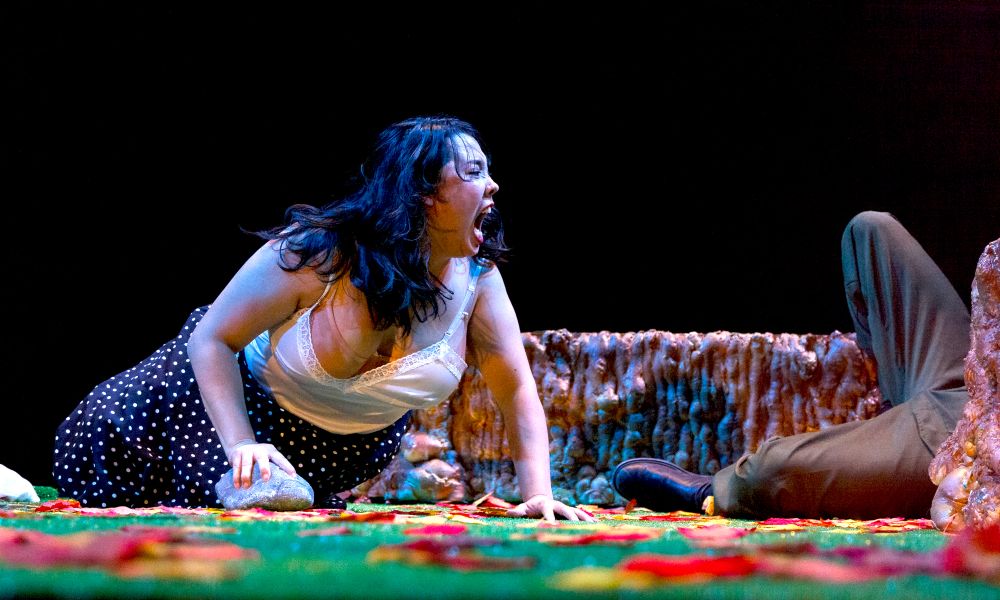Putting on The Moss Maidens—the production that won the Best Play and Best Ensemble awards at SheNYC, a recent theater festival—felt particularly cathartic for the play’s Jewish cast and crew members.
The play portrays a band of five non-Jewish young women living in a mid-sized Dutch town in 1941 who find themselves aiding the resistance movement during World War II, not by supporting male fighters from the sidelines, but by seducing Nazis and killing them secretly in the woods.
The Moss Maidens was one of eight plays selected to be performed of the 300 submitted to SheNYC, an annual summer theater festival that ran from July 26 through August 6 in New York City, showcasing plays written and performed by female, transgender and nonbinary artists.
Written by Jewish playwright S. Dylan Zwickel, the play is based on a true story about three Dutch teenagers who killed several Nazi officers.
Zwickel borrowed the play’s title from a Dutch fable with a plotline that paralleled her own. “Moss maidens in Dutch folklore are these tree-elf-fairy figures, and in a lot of versions of mythology, they would seduce hunters and kill them, which is the dark side of them being these pretty fairies in the woods,” says Zwickel.
Plays at the SheNYC festival are guaranteed two performances each, and they may be offered a third if they are a top seller, says The Moss Maidens producer Mara Jill Herman. After the play’s third performance sold out quickly, the cast and crew asked the festival to sponsor a fourth performance, which sold out as well, and The Moss Maidens became the first SheNYC play to be extended twice and sell out four performances in one season.
In Zwickel’s interpretation of the historic tale, the women begin to intentionally lure Nazis into the woods after one of the group’s members goes on a walk with a Nazi in a forest near town. After he makes unwanted sexual advances at her, they engage in a brief physical struggle, and he falls into the nearby river and drowns.
But after this initial somewhat-accidental death, the group realizes that they can use both the woods’ seclusion and their sexuality to their advantage.
As the women bring more Nazis to the woods, they start to kill them intentionally; they initially kill their targets using impromptu tactics like blunt force trauma to the head, but by the end of the play, the Nazi-hunting women are practicing shooting with pistols and targets, murdering their Nazi foes with precise gunshots.
“The reason that I wanted to write it is that anger that lives in all of us about the Holocaust, and wanting to—instead of telling a story of Jewish suffering, which is what most stories about that time period are—have the catharsis of telling the story of killing Nazis instead, getting to watch people fighting back,” says Zwickel.
Leana Gardella, a fight and intimacy director who helped coordinate the scenes between the Nazis and resistance fighters throughout the play, added that producing a narrative grounded in a true story comes with its own challenges. Actors, crew members and viewers all understand the real implications of the hateful and violent themes that the protagonists wrestle with throughout the play. “Dealing with work that has moments of antisemitism in it and moments of violence acted upon people by Nazis is very loaded,” says Gardella.
Promoting a connection between their modern audience and the play’s 82-year-old context, Zwickel and Daniella Caggiano, the play’s director, decided to loosen the play’s grip on its setting in early-1940s Europe. For example, the performance’s dialogue is reminiscent of the mid-20th century, but Zwickel and Caggiano intended the characters’ playful tones of voice and witty back-and-forths to be something that their contemporary viewers could sympathize with.
“Allowing your commitment to a time period in a historic piece to be porous can actually be really helpful for audiences connecting to it,” says Caggiano. “Because if you take the pressure off of it feeling like this is a time capsule, and more like there is a little exchange between the world the characters are in and the world we’re in, I think it’s much easier to relate.”
The dark, serious themes that accompanied the play’s historical settings are not tampered with. In an interesting creative decision by Zwickel, eight Nazi characters appear on stage throughout the production, and each wears a Nazi uniform with a bright red armband embellished with a distinctive black swastika. Some of these Nazis say they work menial desk jobs while others tell the women about their deep desires to carry out the Final Solution, but all eight Nazis are played by the same actor—in this production, Aaron Matteson— in order to pose a moral dilemma to the audience.
“If you acknowledge the humanity of one Nazi in one scene, you have to acknowledge the humanity of them in all of the scenes, because they’re literally the same human,” as Matteson plays each Nazi seen during the play, says Zwickel.
Matteson added that donning Nazi garb for the performances felt more weighty and difficult than putting on any other costume as an actor, but that all the Nazis he played shared another similarity: none of them question the morality of his murderous actions, in contrast to the resistance fighters.
“In the play, these young women—some of whom are teenagers—have such a keen moral sense throughout. Even though they are killing Nazis, who are the clearest oppressors in modern history, they’re still at every moment asking themselves, ‘Is what we’re doing right? Is what we’re doing okay?’ They’re always checking in,” says Matteson.
Top image: ‘The Moss Maidens’ is inspired by a real group of Dutch teenagers who seduced Nazis in order to lure them into the woods and kill them, forming a small, active, and often overlooked part of the resistance movement. (Credit: Cathryn Lynne)


